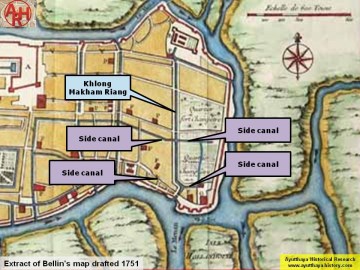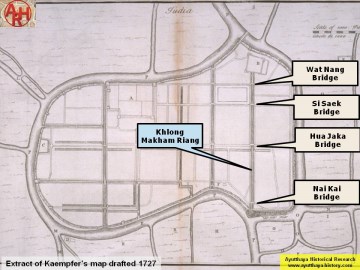
| KHLONG MAKHAM RIANG (คลองมะขามเรียง) |
| Text & photographs by Tricky Vandenberg - June 2013 |
| Khlong Makham Riang or the Canal of the Lined up Tamarind Trees (1), before called Khlong Nai Kai, is a still existent canal situated east on Ayutthaya's city island. The canal was a shortcut (khlong lat) in the oxbow of the old Lopburi River. It has today its origin at Khlong Ho Ratana Chai below Wat Senasanaram and the Front Palace; and its mouth at the present Chao Phraya River, west of Phet Fortress. At the mouth was one of the eleven water gates of Ayutthaya called Pratu Nai Kai. Today this water gate is replaced by a water regulator. Khlong Makham Riang is one of the three large canals running north to south of which two still are in existence. Khlong Makham Riang must have been at the birth of Ayutthaya, an eastern defense moat outside the city. In the 16th century is was the eastern city moat (see: Eastern city limits of Ayutthaya in 1569). Villages such as Ban Khamin and Bang Ian, as the old Elephant Kraal near Wat Song were outside the city walls. After the fall of Ayutthaya in 1569, the city expanded until the Khlong Khue Na for purpose of defense. When Khlong Khue Na became the new eastern city moat, Khlong Makham Riang lost its basic function. On the west bank of Khlong Makham Riang from North to south stood Wat Nang, Wat Salak, Wat Khok Rak, Wat Saphan Ngern, Wat Ho Rakhang, Wat Jek, Wat Singhasai and Wat Tha Ma. On the east bank stood Wat Langka, Wat Phao Khao, Wat Khok Krabu, Wat Kamphaeng and Wat Tha Pho. Four bridges crossed the Makham Riang Canal. In the north was a brick bridge called Saphan Wat Nang going to Ho Ratana Chai or the Tower of the Jewels of Victory (today's bridge on Pa Maphrao Rd); continuing south crossing the road leading to Pa Than was a wooden bridge called Saphan Si Saek (today's Naresuan Bridge on Naresuan Rd); the Saphan Hua Jaka was a large bridge leading to Talaeng Kaeng (today's Pa Thon Bridge on Pa Thon Rd) and finally in the south was a brick bridge called Saphan Nai Kai. The Makham Riang Canal today has more bridges such as the Ho Ratana Chai Bridge on Ho Ratana Chai Rd, Chaloem Phra Kiat 72 Phansa Bridge on Bang Ian Rd, and finally the Rojana Bridge on Rojana Rd. Smaller canals, inexistent today, were branching off from Khlong Makham Riang. On the west bank, a canal leading to Wat Pa Nai passing Wat Chatthan had its origin south of the Hua Jaka Bridge. The same small canal continued on the east bank (see Bellin's map). Near the water gate Pratu Nai Kai, a small canal was dug on the west bank from Khlong Makham Riang to Khlong Pratu Jin. On the opposite side of the canal another small canal lead to Wat Suwan Dararam. The old denomination of Khlong Makham Riang being Khlong Nai Kai, is mentioned in the Royal Chronicles of Ayutthaya in the paragraph on the "War With Lawæk" in 1575. [1] Nai Kai was in fact the name of a quarter in the city. The Phet Fortress was called Nai Kai Fort in the same chronicles. At present Khlong Makham Riang, same as Khlong Tho - Chakrai Yai became unfortunately an open sewer. Filthy household waters are drained into the canal. As the water in the canal is stagnant it could be a cause of spread of malaria, dengue and other diseases (breeding ground of mosquitoes). The initiation of a project to create a permanent water flow (current) through the canals of the city of Ayutthaya and into Bueng Phra Ram, by connecting all the remaining canals and using the current water regulators could improve the present situation. Water flow inside the canals would bring oxygen in its waters (plants & fish life), ventilation and coolness in the city and reduce largely the risk of spread of tropical diseases. Footnotes: (1) Makham (มะขาม) - Tamarind (Tamarindus indica) is a leguminous tree in the family Fabaceae indigenous to tropical Africa. The genus Tamarindus is a monotypic taxon, having only a single species. The tamarind tree produces edible, pod-like fruit which are used extensively in cuisines around the world. Other uses include traditional medicines and metal polishes. The wood can be used in carpentry. [Ref: Wikipedia] / Riang (เรียง) - Lined up. References: [1] The Royal Chronicles of Ayutthaya - Richard D. Cushman (2006) - page 79 / Source: Phan Canthanumat, British Museum, Reverend Phonnarat, Phra Cakkraphatdiphong & Royal Autograph - War With Lawæk, 1575. |




| (Detail of Kaempfer's map - 1727) |
| (Detail of Bellin's map - 1751) |
| (Detail of Bellin's map - 1751) |
| (Detail of Phraya Boran Rachathanin's map - 1926) |